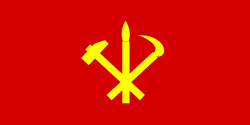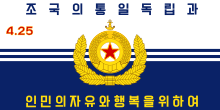Flag of North Korea
 | |
| Use |
National flag and ensign |
|---|---|
| Proportion | 1:2 |
| Adopted | 8 September 1948 |
| Design | A wide red stripe at the center, bordered by a narrow white stripe both above and below, followed by a blue stripe. The central red stripe carries a five-pointed red star within a white circle near the hoist. |
| Designed by | Unknown |
| Flag of North Korea | |
| Chosŏn'gŭl | 람홍색공화국기(발) |
|---|---|
| Hancha | 藍紅色共和國旗(발) |
| Revised Romanization | ramhongsaek gonghwagukgi(bal) |
| McCune–Reischauer | ramhongsaek konghwagukki(ppal) |
| Chosŏn'gŭl | 홍람오각별기 |
| Hancha | 紅藍五角별旗 |
| Revised Romanization | hongramogakbyeolgi |
| McCune–Reischauer | hongramogakpyŏlgi |
| Chosŏn'gŭl | 인공기 |
| Hancha | 人共旗 |
| Revised Romanization | in-gonggi |
| McCune–Reischauer | in'gonggi |
The flag of North Korea is the ensign and national flag of North Korea. It was adopted on 8 September 1948[1] and is defined in Article 170 of Chapter VII of the North Korean constitution.
Design

According to article 170 of Chapter VII of the Socialist Constitution of the Democratic People's Republic of Korea (North Korea):
The national flag of the Democratic People's Republic of Korea consists of a central red panel, bordered both above and below by a narrow white stripe and a broad blue stripe. The central red panel bears a five-pointed red star within a white circle near the hoist.The ratio of the width to the length is 1:2.[2]
Symbolism
.svg.png)
The North Korean flag's prominent red star is a universal symbol of communism,[3] although since the flag's adoption, the application of the Marxist-Leninist-natured philosophy of Juche has replaced communist authority as the state's guiding ideology, and references to communism have been systematically removed from the country's constitution and legal documents.[4]
The red stripe expresses revolutionary traditions. The two blue stripes stand for sovereignty, peace and friendship. The white stripes symbolize purity.
The website of the Korean Friendship Association indicates, on the contrary, the red star represents revolutionary traditions, the red panel is indicative of the patriotism and determination of the Korean people. The white stripes symbolizes ethnic purity of the unified nation and its culture. The blue stripes represent unity.[3][5]
According to a typical North Korean official text published in Rodong Sinmun,[6] Kim Il-sung gave the following significance to the elements of the flag:
The red colour of the flag symbolises the anti-Japanese fervour, the red blood shed by the Korean patriots and the invincible might of our people firmly united to support the Republic. The white colour symbolises the one bloodline, one land, one language, one culture of our monoethnic country, which lived in purity. And blue stands for the gallant visage of our people, symbolising the spirit of the Korean people fighting for world peace and progress.[6]
The colors of the North Korean flag – red, white and blue – are considered national colors and symbolize respectively: revolutionary traditions; purity, strength, and dignity; and sovereignty, peace, and friendship.[7]
History


When the northern portion of Korea became a socialist republic supported by the Soviet Union following the restoration of independence of Korea in 1945, the Taegukgi was once again in use.[6]
Vice Chairman of the Provisional People's Committee for North Korea Kim Tu-bong was in favor of keeping the Taegukgi, but in 1947 the Soviets communicated via Major General Nikolai Georgiyevich Lebedev their wish to have the flag changed. The old flag with its traditional Korean elements, he noted, "sounds like a legend to me". Kim yielded and a few months later the design for the new flag was dictated from Moscow, although it is not known who exactly was the Soviet official that designed the flag. Before its formal adoption, the Taegukgi remained in official use.[6][8]
The design of the flag was disclosed, along with a draft constitution, on 1 May 1948.[9] In July 1948 the new flag was approved by the provisional North Korean People's Assembly. The following month Kim, who had formerly supported the traditional design, wrote a reasoned text On the Establishing of the New National Flag and the Abolition of Taegukgi. Thereby he explained the decision to adopt a new flag against the wishes of those who favored the old one In terms of North Korean official texts, Kim's account is unequivocally frank in acknowledging dissenting public opinion. Much later, in 1967, Kim Tu-bong was purged by Kim Il-sung who by that time had erected a cult of personality. Any mention of the use of Taegukgi was removed from texts and it was doctored out of photographs on the orders of Kim Il-sung who sought to monopolize North Korean history to serve him. Contemporary official North Korean accounts present the new flag of North Korea as personally designed by Kim Il-sung.[6]
A 270-kilogram (600 lb) North Korean national flag flies from the world's fourth tallest flagpole, which is located at Kijŏng-dong, on the North Korean side of the Military Demarcation Line within the Korean Demilitarized Zone. The flag-pole is 160 meters (520 feet) tall.
Other flags
There are several other known flags in use. There are flags for the Korean People's Army (KPA), and its two subdivisions the Korean People's Air Force and Korean People's Navy, which follow a common design but with different colors (blue and white for the Navy and dark blue and light blue for the Air Force). There is also a flag of the ruling Worker's Party of Korea, modeled after similar communist party flags, and a flag for the Supreme Commander of the KPA used by Kim Jong-un, which has the Supreme Commander's Arms on a red field. KPA Guards units use the same common design but with the national arms at the center of the obverse.
-

Proper vertical display of the WPK flag
-
.svg.png)
Flag of North Korea under the Soviet Civil Administration (October 1945-February 1946)
-

Flag of the Provisional People's Committee for North Korea (February 1946-July 1948)
-

Flag of the Workers' Party of Korea
-

Standard of the Supreme Commander
-

Korean People's Army
-

Korean People's Army Ground Force
-

Korean People's Navy
-

Guards Ensign
-

Naval Ensign
-

Korean People's Air Force
-

Unification Flag of North and South Korea
-

A series of North Korean flags
See also
References
- ↑ "North Korea". flagspot.net. Retrieved 2016-08-10.
- ↑ "Chapter VII, Article 170". Socialist Constitution of the Democratic People's Republic of Korea (PDF). Pyongyang: Foreign Languages Publishing House. 2014. p. 35. ISBN 978-9946-0-1099-1 Amended and supplemented on April 1, Juche 102 (2013), at the Seventh Session of the Twelfth Supreme People's Assembly.
- 1 2 "North Korean Flag". web.archive.org. Retrieved 2016-08-10.
- ↑ "DPRK has quietly amended its Constitution". Leonid Petrov's KOREA VISION. Retrieved 2016-08-10.
- ↑ "Flag and emblem". Retrieved 31 March 2013.
- 1 2 3 4 5 Tertitskiy, Fyodor (20 June 2014). "Kim Tu Bong and the Flag of Great Extremes". Daily NK. Retrieved 10 August 2016.
- ↑ "Korea, North". The World Factbook. Central Intelligence Agency. Retrieved 22 September 2015.
- ↑ North Korea: A Guide to Economic and Political Developments By Ian Jeffries
- ↑ Pringsheim, Klaus H. (1967). "North Korea Under the Hammer and Sickle: A Non-Marxist view". In Shaffer, Harry G. The Communist World: Marxist and Non-Marxist Views. New York: Ardent Media. p. 439. OCLC 228608.
External links
| Wikimedia Commons has media related to Flags of North Korea. |
| Wikinews has related news: London Olympics organizers apologize after North Korea flag gaffe |
